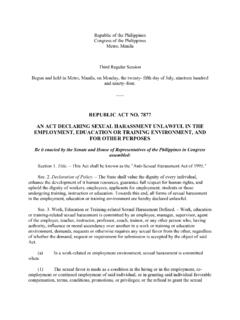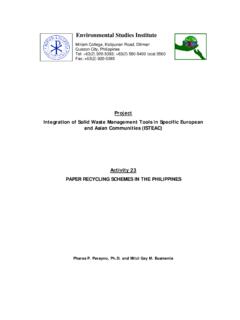Transcription of 2009 Typhoon Ondoy Flood Disasters in Metro Manila
1 Natural Disaster Research Report of the National Research Institute for Earth Science and Disaster Prevention, No. 45 ; February, 2011 63 2009 Typhoon Ondoy Flood Disasters in Metro ManilaTeruko SATO* and Tadashi NAKASU**Visiting Researcher, National Research Institute for Earth Science and Disaster Prevention,*Tokiwa University, Japan**International Centre for Water Hazard and Risk Management under the auspices of UNESCO (ICHARM), JapanAbstractFrom September 25 26, 2009, Typhoon #16 ( Ondoy ) struck southwest Luzon in the Philippines. Flood Disasters caused by this heavy rainfall affected 872,097 people throughout the entire metropolitan area, causing 241 fatalities, 394 injuries, and damaging 65,521 buildings (of which 12,563 were completely destroyed).
2 Infrastructure damages (not including agricultural losses) amounted to 570,187,587 philippine pesos (NDCC, 2009a). We investigated the great urban Flood disaster that occurred in the megacities of the developing country, which are expected to grow to a population of 25 million by 2015. The conditions caused by runoff, flooding, and damages as well as mitigation measures relating to the hydrological conditions, land environments, and social economic conditions in the Philippines are reported based on field investigations and interviews with related words: 2009 Typhoon Ondoy , Urban Flood , Metro Manila , Pasig-Marikina-Laguna Lake Complex1. IntroductionFrom September 25 26, 2009, Typhoon #16 ( Ondoy ) struck the southwest Luzon in the Philippines, causing torrential rainfall.
3 Within 24 hours, mm of rain fell at the Quezon City Science Garden, mm fell at the Port Area, and mm fell in the municipality of Tanay in neighboring Rizal province. The amount of precipitation at the Science Garden reached levels expected only once per century or more (for rainfall in a 24-hour period) or once every 150 years or more (for rainfall in a 12-hour period), and the 92 mm of rain that fell between 11 and noon was of a level expected only once every 5 10 years (PAGASA, 2009). This heavy rainfall affected 872,097 people throughout the entire metropolitan area, causing 241 fatalities, 394 injuries, and damaging 65,521 buildings (of which 12,563 were completely destroyed).
4 The infrastructure damages (not including agricultural losses) amounted to 570,187,587 philippine pesos (NDCC, 2009a; NDCC, 2009b). Other such losses were caused by traffic coming to a standstill due to major city center thoroughfares such as Epifanio de los Santos Avenue being cut off by Flood water and by the cancellation of domestic and international flights at Manila airport ( Manila Shimbun, 27 Sept.).In this chapter, we discuss the Flood Disasters that occurred in the Manila Metropolitan Area ( Metro Manila ), which is a major region in the developing country and one of south-east Asia s most prominent overpopulated centers with a population of million according to the 2007 Census of Population, of which population growth rate is 2.
5 Surveyed AreaAs Fig. 1 shows, Metro Manila comprises 16 cities and the municipality of Pateros, all of which lie within the Pasig-Marikina-Laguna Lake Complex (catchment area: 4,678 km2) except for parts of the north and the southernmost tip which lie along Manila Bay (Fig. 2). This chapter concerns the Flood Disasters that took place in this river River systems and Flood -prone River SystemsAs its name suggests, the Pasig-Marikina-Laguna Lake Complex consists of two rivers and one lake. One of these is the Marikina River, which has a catchment area of km2 (at the Napindan junction) and flows out from the Sierra Madre mountain range in the east part of the river basin. The Marikina River meanders its way southwards along the Marikina River Flood plain, and floodwater is diverted into the * Miwa 1-430-1, Mito, Ibaraki, 310-8585, Japan** Minamihara 1-6, Tsukuba, Ibaraki, 305-8516, JapanNatural Disaster Research Report of the National Research Institute for Earth Science and Disaster Prevention, No.
6 45 ; February, 2011 64 Manggahan floodway from the Rosario weir in the left bank, where the Upper Marikina River becomes the Lower Marikina River. The Lower Marikina continues southwards, and at Napindan junction it is joined by the Pasig River that flows north from Laguna de Bay (Laguna Lake). The Pasig River is the only river that flows out from Laguna Lake. The Napindan channel flows north from the north coast of Laguna Lake, and where it joins the Marikina River, it starts to flow northwest across the central plateau and into the coastal lowland alongside Manila Bay and then out into the bay near the old city district at the center of the lowland area. The Pasig River is joined by the San Juan River as a right tributary, which has the central plateau as its river basin.
7 With an area of 900 km2, Laguna Lake is the largest lake in the Philippines, occupying a large region extending from the central to southern parts of the river basin. The lake has a catchment area of 3,820 km2, which is about 80 % of the total catchment area. This wide and shallow lake temporarily stores the water flowing from at least 20 tributary river basins, and during floods it functions as a retarding reservoir for the Marikina River. Water levels fluctuate from m elevations in the summer months to m in the rainy seasons. The annual mean is an m elevation (Edgardo C. Manda, 2008). When the sea level in Manila Bay is higher than the water level in the lake, the water flows backwards from the sea into the Flood -prone areas The Flood -prone areas in the Pasig-Marikina-Laguna Lake Complex can be divided into the following four Flood plains as depicted in the Flood hazard map in Fig.
8 3:1) Coastal lowlands alongside Manila Bay: Land with an altitude of 3 meters or less next to Manila Bay and down the Pasig River. This lies at the center of Metro ) Marikina Flood plain: Alluvial lowland with an altitude of 5 30 m along the Marikina River, which is being developed to the north and south at the western end of the river basin. It is bounded to the west by the central plateau that lies between the Manila Bay coastline and the coastal lowland and to the east by the Sierra Madre mountain range from where the Marikina River ) Laguna Lake Plain: The Marikina Flood plain continues on into the Laguna Lake Plain. This is a marshy plain with an altitude of just a few meters, where it is affected by the rise of the water level of Laguna Lake.
9 4) Valley plains cutting through the central plateau: Narrow lowland areas alongside the Pasig and San Juan Rivers where they cut across the central plateau. In these Flood plains, even floods with an estimated frequency of once every 2 10 years (shown in yellow) are liable to cover a substantial part of these areas, while floods with an estimated frequency of once every 50 100 years (blue) are liable to cause Flood damage over the entire Flood plain (Fig. 3). 4. Locality of Flood disastersThe flooding of Metro Manila varies according to the hydrological conditions and land environments of the Flood plain and river basins. Table 1 shows the characteristics of flooding and Flood damage in Metro Manila and how the Flood inundation and damage varied between the four Flood plains.
10 Inner water inundation may have also occurred in the river basins where there was severe external overflow, but this figure charts the inundation phenomena that caused most of the damage. Furthermore, administrative districts sometimes cross over multiple topological zones and were therefore divided into their main topological a result, the flooding of Metro Manila can be divided Fig. 1 Map of Metro Manila (MMDA, 2009).2009 Typhoon Ondoy Flood Disasters in Metro Manila T. SATO and T. NAKASU 65 into regions where increased damage was mainly caused by external flooding and into regions where it was mainly caused by inner flooding. The Marikina Flood plain and San Juan valley plain can be placed in the former category and the Laguna Lake Plain and coastal lowlands along the Manila Bay coast can be placed in the latter, which can also be subdivided into the coastal lowlands, which experienced a short flooding duration, and the Laguna Lake Plain, where the flooding persisted for more than two Marikina Flood plainIn the Marikina Flood plain, where damage was mainly caused by external flooding, overflow well in excess of twice the river channel discharge capacity occurred, and the water level in the river rose rapidly by approximately 3 m in 3 h.





